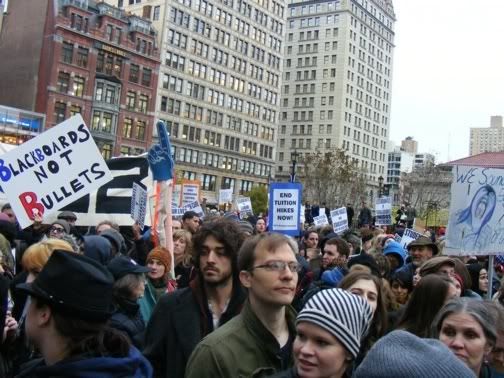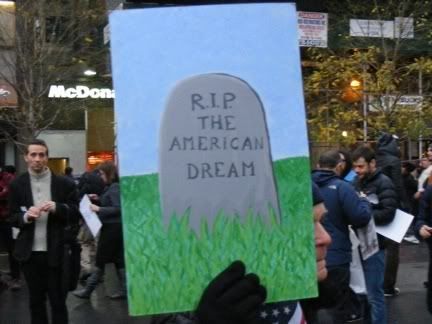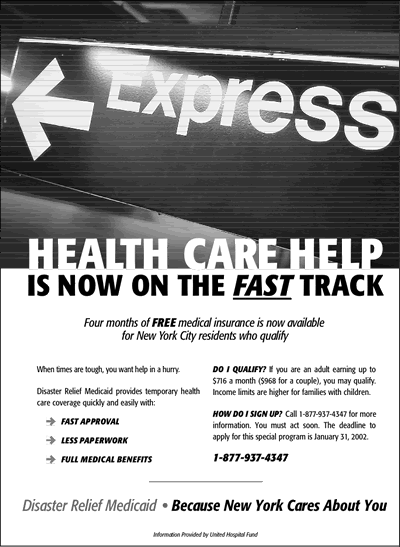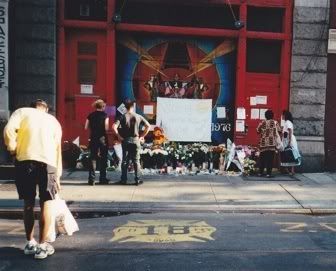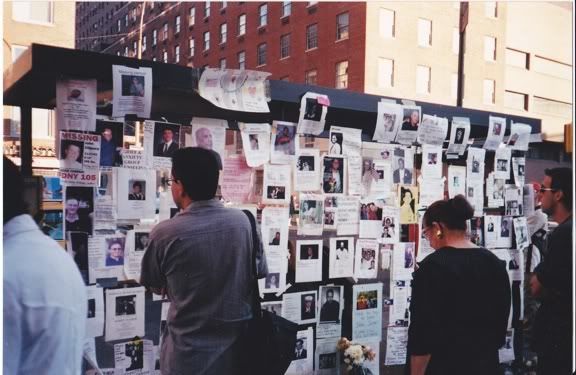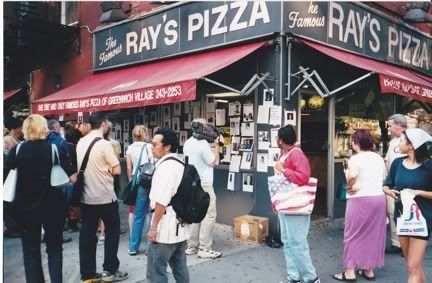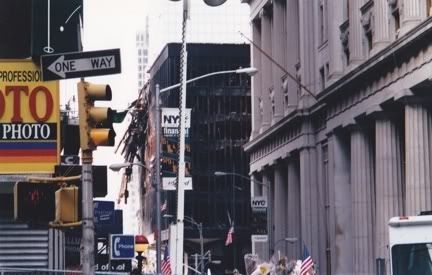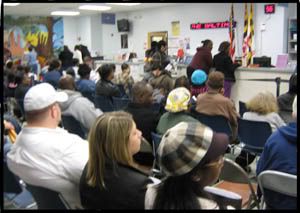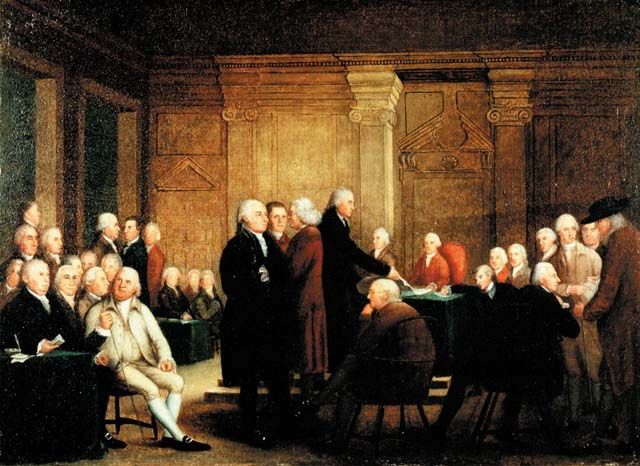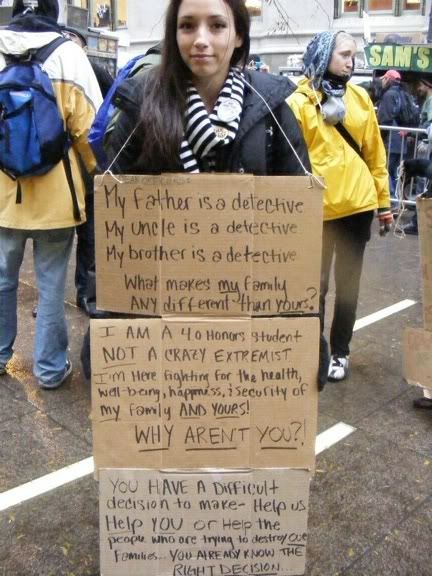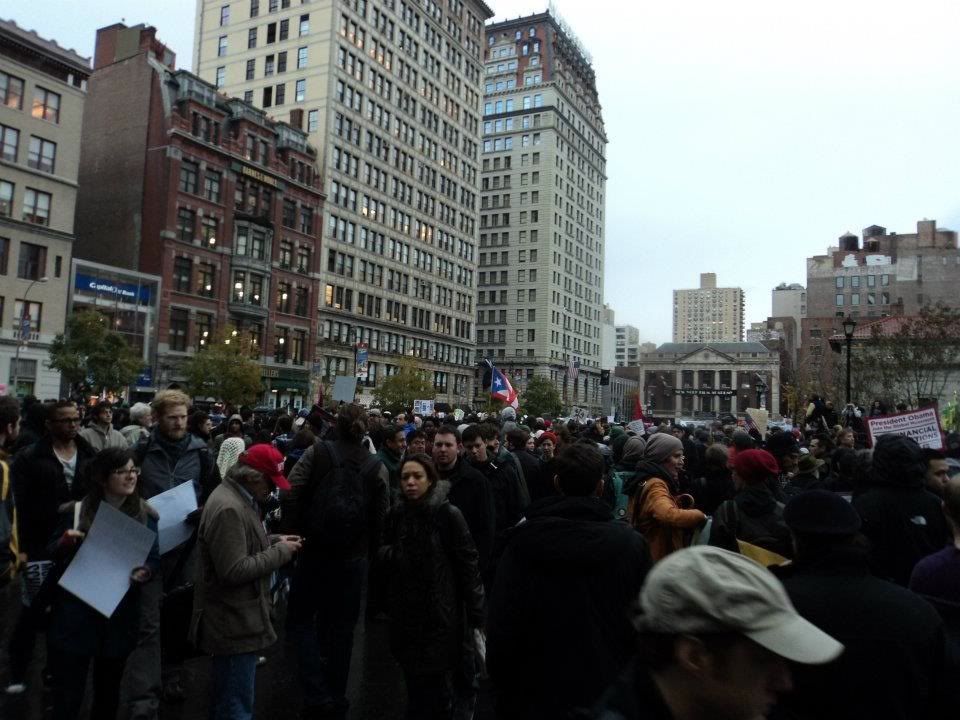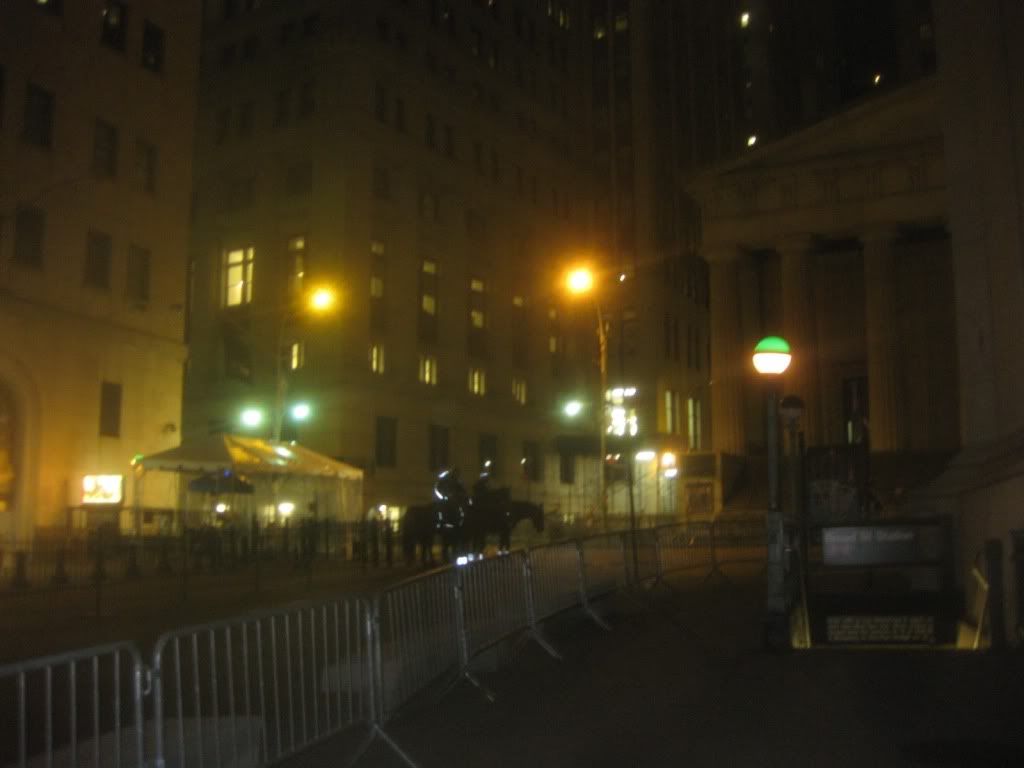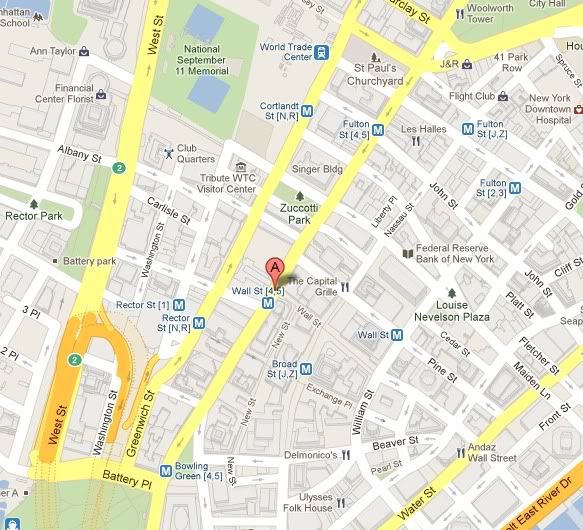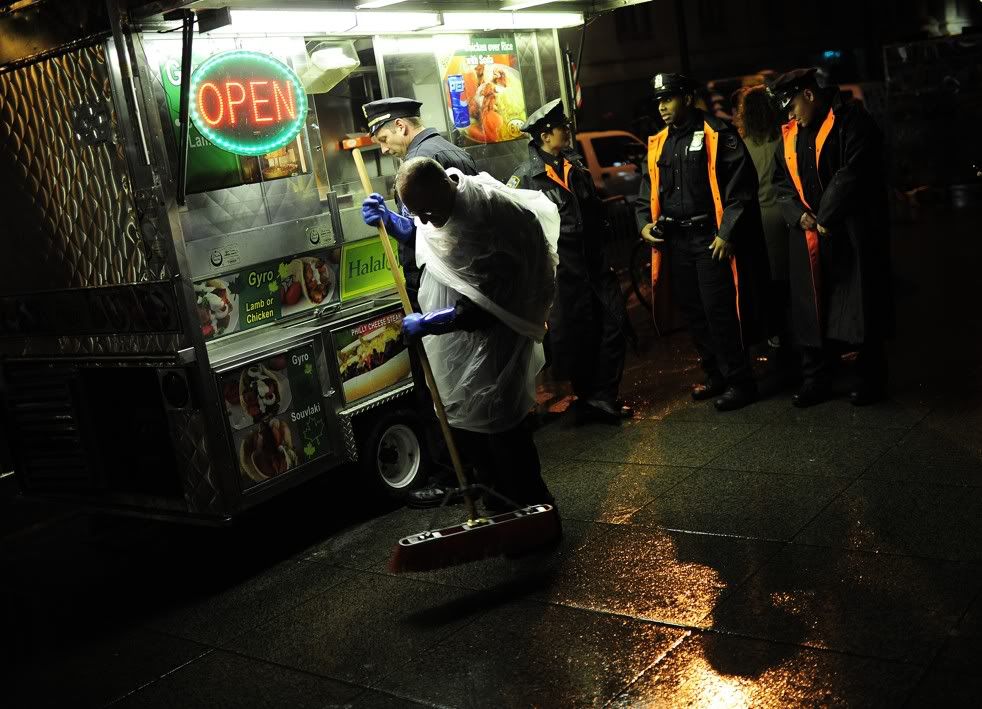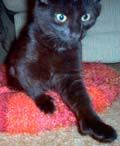Rally in Union Square. Photo: Chris Clarke
Yesterday was November 17, and Mr. O'Kitten and I went downtown to join the Occupy Wall Street march. I didn't really know what to expect, or even where to go exactly, but after Bloomberg's wee hours closure of Zuccotti Park, seizure of the OWS People's Library (containing over 5,000 books), and subsequent harassment of people trying to go in and out of the Zuccotti Park, I was determined to participate in some small way.
I knew that there were actions planned beginning at 7am at the New York Stock Exchange and continuing throughout the day, but I had a noon appointment and Mr. O'Kitten had a class. We met up around 2pm just a few blocks from Zuccotti Park at Foley Square, which was already being barricaded by dozens of police officers. Mr. O'K was coming from City Hall, where there had been hundreds of marchers, police in full riot gear, and tension in the chilly autumn air.
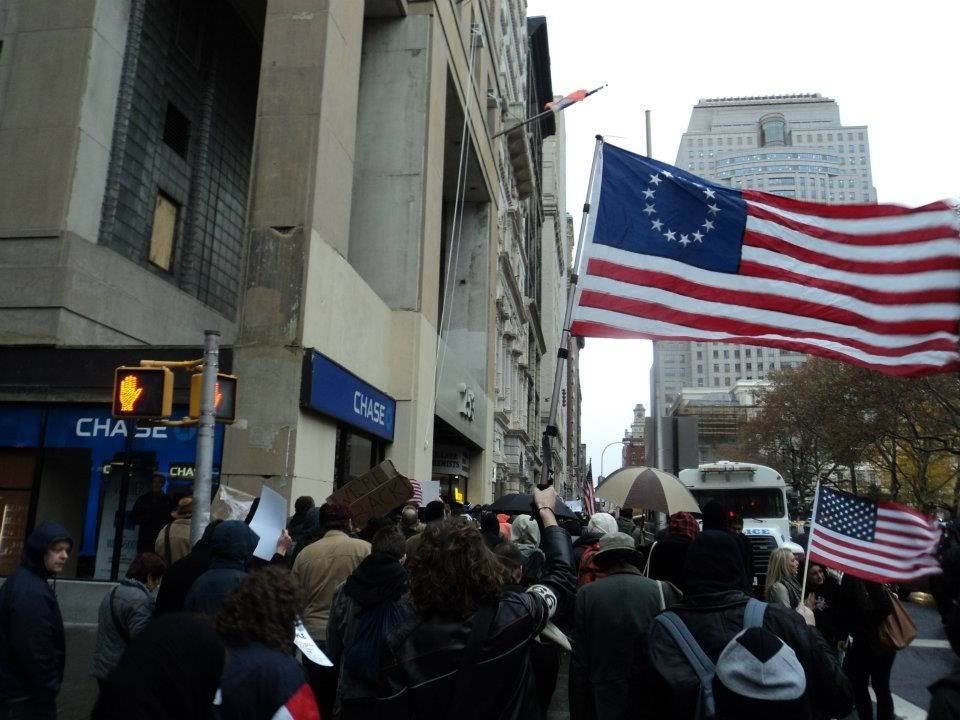
Marchers on Lower Broadway. Photo: Chris Clarke
Mr. O’K reported that he’d been among a sizeable group of marchers heading south, and we met them coming back up Broadway in a drizzly rain. Dozens of police officers in single file walked alongside the enormous group, ordering anyone who stepped off the sidewalk back onto it. The NYPD officers occupied an entire lane of Broadway and we filled the sidewalk in the cold drizzle. I have no idea how many blocks of marchers there were, but when we crossed Canal and proceeded through SoHo, our chants echoed off of the tall cast iron buildings and filled Broadway with a tremendous chorus of voices. People stood in every storefront to see what was going on, taking photos and video along the entire route, many waving and smiling in solidarity. The windows and fire escapes over Broadway were also full of on-lookers, some waving their own posters and signs of support.
The rain stopped as we reached Union Square, having covered a distance of about three miles. We threaded our way alongside the Holiday Market (which was barricaded off), moving slowly through a narrow passage toward 16th Street. The entire northern half of the park was already full. The portion of the OWS protesting oppressive student debt had already begun, and I had no idea how many marchers were still behind us, yet to arrive.

Rally in Union Square. Photo: Edward "Eak" Arrocha
At this point I’d like to address the criticism that OWS "does not have a clear list of demands." As you look at photos or watch coverage of OWS, you will also notice signs with different viewpoints on them. However, one unifying point is the shared feeling that our current political system does not equally serve every citizen, but is biased toward (if not actually owned by) the rich and powerful. Convenient shorthand for this idea is the "1%," indicating "the richest 1% of people [that] are writing the rules of an unfair global economy" that does not work for most of us (perhaps 99% of us). There is the opinion that this is not democracy, accompanied by a strong desire to fix it.
The Declaration of the Occupation of New York City, drafted in late September, does include a list of grievances that includes inequality and discrimination; environmental destruction and oil dependence; corporate control of the media, the courts, the government, and the economy; bank bailouts, executive bonuses at taxpayer expense, and improper seizure of homes during the mortgage crisis; lack of regulation of campaign finance; the right to education, privacy, and health care; and more.
We left Union Square and headed back downtown, to Foley Square. For two blocks, we were allowed to march in the street. This seemed odd to me, even as we triumphantly spread out across Fifth Avenue. Mr. O'K and I were somehow within a couple hundred people of the front of the march. At Fourteenth Street, we were blocked by a police barricade across the entire intersection. Shouts and gestures of "Go back! Go back!" began. Of course, turning a crowd of thousands around would be difficult, even if the massive group could successfully employ something like the People's Microphone.
Then it seemed like we could go forward. Cheers ensued.
But we were mistaken. "Turn around! Turn around!" Confusion. Drums were beating. People were chanting, waving flags. So much energy was contained in the thousands of bodies standing there with their hearts pounding and muscles coiled after walking for miles in the chill rain and then rallying, chanting, applauding and cheering in the park. The need to surge on was strong. The line of officers and police vans was like a small, frail dam trying to hold back a tsunami. A potentially very angry tsunami.
I overheard some people yelling, "Go around! Go around!" and I asked someone, "Can we go around? Because that's what we should do.” I tried to see the police officers over the heads of the crowd but I couldn’t. “I bet they want a confrontation."
Just then, a handful of people began shouting, "Sidewalk! Sidewalk!" We headed for it.
When we got close, a small knot of guys was similarly trying to figure out what to do. One of them was saying, "I think we should push through. We have thousands of people here. We can take them."
"But can we go around?" I asked.
"Well, there's a sidewalk, but it's just a trickle."
"If you try to push through, there'll be a confrontation," I said. "I bet they set up this blockade on purpose. We should just go around."
"It'll take forever to go around," he said. "I have friends in that building right there I can call," he added, indicating the opposite corner, where the second-story windows were papered with big signs saying "Occupy Students and Teachers/Take Back That Which is Yours." People were standing in the windows, waving their fists in the air. He looked at his phone.

Fifth Avenue and Fourteenth Street. Photo: Chris Clarke
His friends started yelling, "Push through! Push through!"
I grabbed Mr. O'K and pulled him toward the corner. "I don't want to get caught here if there's going to be a battle with the police. If we can go around, we should. I bet they set it up like this to channel people onto Fifth Avenue and then stop them at the barricade on purpose. Let's go."
On Fourteenth Street, when we were moving again, about half a block from the barricade, another guy concurred with me. "They thought they could stall us there. The best thing is to keep moving--be flexible. They wanted to stop the march and wait us out."
I don't know if the police were that smart or not, but it occurred to me later that even if they hadn't planned to trap thousands of marchers in a dead end, it couldn't have worked out better for them. I still don't know if there were any altercations at the corner of Fifth Avenue and Fourteenth Street, but I hope not. All I know is that soon enough we were heading across the south end of Union Square and turning south to head back down Broadway, close to the head of a column of thousands of marchers, and evening was falling.
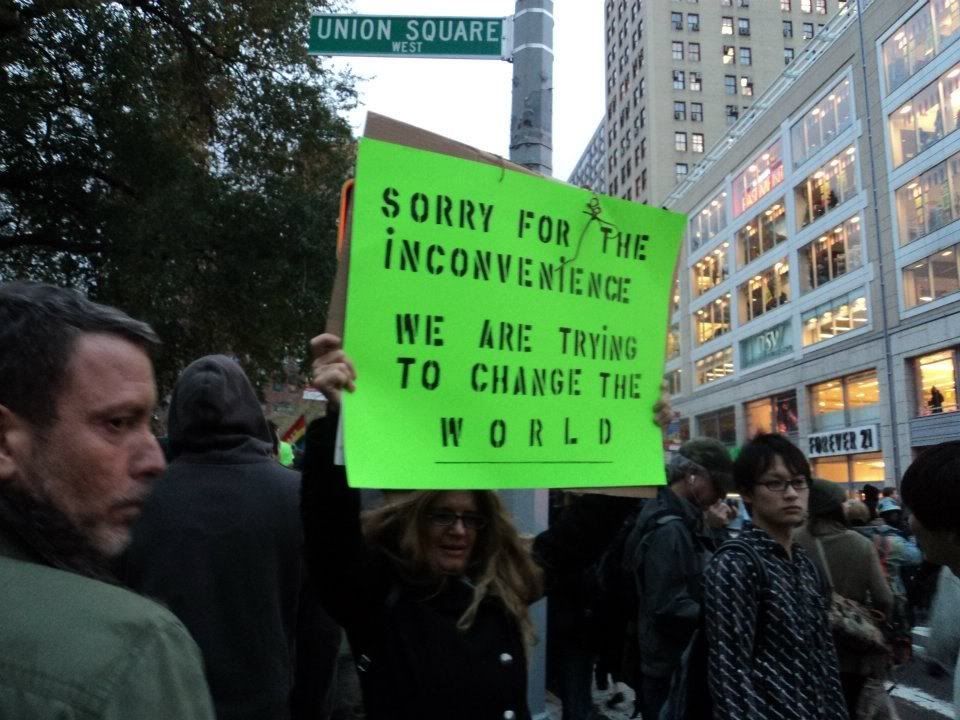
Union Square. Photo: Chris Clarke
It wasn't as cold as it had been in the afternoon, and there hadn't been any more rain. We made much slower progress than we had earlier in the day. The police regrouped almost as quickly as the marchers, and soon enough we were again flanked by a long column of officers. They walked in the western lane of Broadway, and we filled the sidewalk, doing our best to let pedestrians through. I noticed some things I hadn't earlier in the day, like the helmets most of the officers wore, which looked like motorcycle helmets that also covered the neck. Many of them had clusters of zip ties, the kind they use for handcuffs, hanging at their knees, and their batons looked really long and shiny.
There were about five helicopters in the air, one of which was a police helicopter hovering really low overhead. Police cars kept careening down Broadway, sirens yowling, interspersed with several NYPD buses--the kind they transport prisoners in. We passed a number of NYPD Communications Command Unit vans, their rooves full of James Bond-looking spy stuff. I also noticed a number of officers with hand-held video cameras filming us as we marched by.
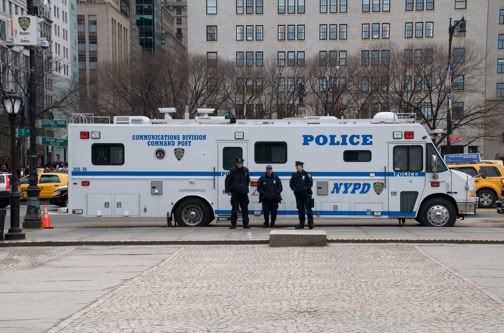
An NYPD Communications Division Command Post
All through the day, I was continually impressed by the diversity of the crowd. As I mentioned in my previous OWS post, the media’s depiction of OWS protesters as a bunch of disenfranchised "hippie kids" is completely inaccurate. I saw people of many nationalities and skin colors, all ages, and all different backgrounds. Occasionally someone along the route would yell, "Get a job!" and inevitably a number in the crowd would shout back, "I have a job!" So obviously OWS includes both the employed and the unemployed. For awhile we were marching between a group of about eight children (the New York Children’s Brigade) between eight and ten years old who were very concerned about the environment and education and two couples who looked to be in their sixties.
When we finally got to Foley Square, I was astonished that it--like Union Square--was already packed with people. And there were presumably thousands more threading their way toward Foley Park; the column was still making its way down from Canal Street, nearly a mile behind us. It was about 6:30, it was dark, and we were both tired and hungry, so Mr. O’K and I made our way toward the subway.
Right outside the City Hall station, we passed two of the NYPD prison buses we'd seen earlier, both full of people wearing white T-shirts with "99%" emblazoned on them. We stood behind the barricades that lined the street in front of the Manhattan Municipal Building, waving our signs and chanting in solidarity until the buses pulled away, with people cheering and applauding as they passed. It turns out that these buses held the 99 people who had, in a premeditated act of civil disobedience, been arrested in a sit-in earlier on the Brooklyn Bridge. The number intended to draw attention to Occupy Wall Street's message: that OWS represents 99% of Americans.
The most inspiring thing that I've seen happen over the past week--to myself as well as to others--is that our city officials' actions (and those of Mayor Bloomberg in particular, who happens to be America's 12th wealthiest person, worth nearly $20 billion) have caused many people to feel a sense of moral indignation that has long been lying dormant. Subsequently, our political awareness has awakened, pulling us out of our frustration and apathy and spurring us into action.
I thank OWS for setting these events into motion.
